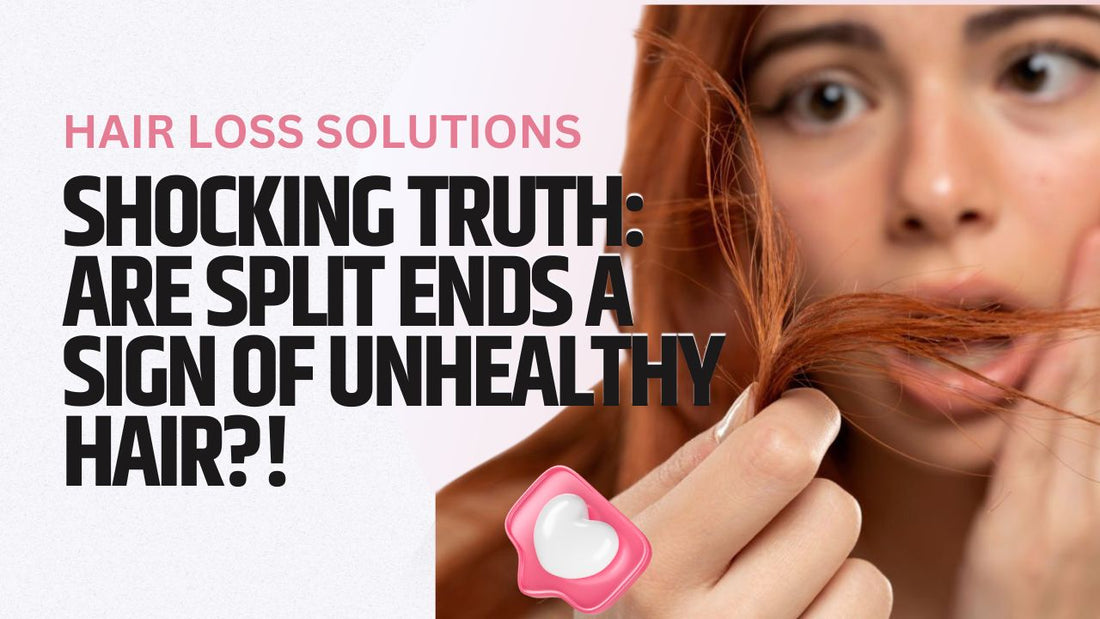
Shocking Truth: Are Split Ends a Sign of Unhealthy Hair?!
Share
Have you ever found yourself inspecting your hair, only to discover those dreaded split ends? If so, you're not alone. Split ends are a common hair woe that many of us have faced at some point in our lives. They can be frustrating, but do they signal something more significant about the health of your hair? In this comprehensive guide, we'll uncover the truth about split ends, debunk myths, explore the science behind them, and provide you with practical tips for healthier hair. So, let's embark on this journey to understand the real story behind those split ends.

Understanding Split Ends
What Are Split Ends?
Split ends, also known as trichoptilosis, occur when the hair shaft splits into two or more strands at the tip. These splits can travel up the hair shaft, causing further damage if left untreated. But what causes these troublesome splits to form in the first place?
Common Causes of Split Ends
Several factors contribute to the formation of split ends. Among them are excessive heat styling, frequent hair coloring or chemical treatments, harsh hair care practices, and environmental factors like exposure to UV rays and pollution.

Types of Split Ends
Not all split ends are alike. Recognizing the types of split ends offers valuable insights into their causes and management strategies. We'll explore the primary types: the classic split, the knot, and the tree.

- The Classic Split End: This is the most recognizable. A single hair strand splits into two or more at its tip. It's caused by factors like excessive heat styling, hair dyes, and environmental stressors. These splits can worsen if left untreated.
- The Knot: Knots are common and form when hair twists into a small knot near the end. They tangle easily and result from friction, rough handling, or dryness.
- The Tree Split: Also known as a multiple split, this type is complex. A single hair strand divides into several smaller branches, resembling a tree. Tree splits indicate severe damage and require more extensive trimming. They're linked to prolonged neglect of hair care and excessive exposure to damaging factors.
Understanding these split end types helps pinpoint their causes. Identifying the type can tailor your hair care routine and treatments effectively. Whether it's protective styling for knots or addressing heat damage for classic splits, a targeted approach promotes healthier, split-end-free hair.
Myths and Misconceptions
Debunking Split End Myths
Myths and misconceptions often surround split ends, leading to confusion and ineffective hair care practices. It's crucial to debunk these widespread fallacies and shed light on the realities of split ends. By dispelling these myths, you can better understand how to care for your hair and address split ends effectively.

Myth 1: Trimming Your Split Ends Boosts Hair Growth
One common misconception suggests that trimming split ends will accelerate hair growth. In reality, cutting split ends doesn't affect the speed at which your hair grows from the scalp. Hair growth primarily occurs at the roots, and trimming split ends merely removes damaged portions of the hair shaft. While regular trims are vital for maintaining healthy-looking hair, they don't influence the growth process.
Myth 2: Hair Products Can Repair Split Ends
Another misconception claims that specific hair products can miraculously repair split ends. Unfortunately, split ends result from structural damage to the hair shaft's outer cuticle layer, and no product can permanently mend these splits. While some products may temporarily mask split ends by smoothing the hair's surface, the only permanent solution is to trim them.
Myth 3: Split Ends Solely Result from Heat Styling
It's a widespread belief that split ends are exclusively caused by excessive heat styling, such as curling irons or straighteners. While heat styling contributes to split ends, they can also arise from various other factors, including chemical treatments, rough hair handling, and environmental stressors. Recognizing the multiple causes of split ends allows for a comprehensive approach to their prevention and management.

By dispelling these myths and gaining a clear understanding of split ends' true nature, you can adopt more informed and effective hair care practices
Signs of Unhealthy Hair
Recognizing Unhealthy Hair
Unhealthy hair exhibits certain characteristics, and split ends can be a visible sign of these issues. Unhealthy hair may appear dry, brittle, and lackluster. It might tangle easily and be more prone to breakage. Recognizing these signs can help you take action to improve your hair's overall health.

The Science of Split Ends
What Happens Inside Your Hair
To truly understand split ends, we'll delve into the science behind them. Each strand of hair is composed of multiple layers, including the outer protective layer called the cuticle. Damage to the cuticle can lead to split ends. We'll explore the hair's structure and how various factors, including heat, chemical damage, and environmental stressors, affect it. This section will provide you with a deeper appreciation for the complexity of your hair.

Hair Care Practices
Preventing Split Ends
Prevention is often the best strategy when it comes to split ends. We'll offer practical tips on how to prevent them, from choosing the right hair care products to adopting gentle hair care practices.
To prevent split ends, start with the basics:
- Regular Trimming: Schedule regular haircuts to trim away existing split ends and prevent them from traveling up the hair shaft.
- Gentle Detangling: Use a wide-toothed comb or a detangling brush to gently remove knots and tangles, starting from the tips and working your way up.
- Avoid Excessive Heat Styling: Limit the use of heat styling tools like hairdryers, straighteners, and curling irons. When you do use them, apply a heat protectant spray.
- Protective Hairstyles: Consider wearing protective hairstyles like braids or buns to minimize exposure to environmental stressors.
- Moisturize: Keep your hair well-hydrated by using a conditioner or hair mask regularly. Dry hair is more prone to splitting.
- Silk Pillowcases: Switch to silk or satin pillowcases to reduce friction on your hair while you sleep.
- Avoid Overwashing: Shampooing too frequently can strip your hair of its natural oils, leading to dryness and potential split ends. Opt for a gentle, sulfate-free shampoo.

Home Remedies
Natural Treatments for Split Ends
For those who prefer natural remedies, we've got you covered. Discover effective and natural ways to treat split ends, including DIY hair masks and treatments. Ingredients like honey, coconut oil, and aloe vera can work wonders to nourish your hair and reduce the appearance of split ends.
- Coconut Oil Mask: Apply warm coconut oil to your hair, focusing on the ends. Leave it on for at least 30 minutes or overnight before washing it out.
- Aloe Vera Gel: Massage aloe vera gel onto the tips of your hair. Leave it on for about 20 minutes, then rinse thoroughly.
- Egg Mask: Beat an egg and mix it with a tablespoon of olive oil. Apply the mixture to your hair and leave it on for 30 minutes before washing it out.
- Honey and Banana Mask: Mash a ripe banana and mix it with honey. Apply this mask to your hair, leave it on for 15-20 minutes, and then rinse.

Professional Solutions
When to Seek Professional Help
In some cases, professional intervention is necessary. We'll discuss salon treatments and procedures that can help address split ends and improve overall hair health. Trimming your hair regularly can also prevent split ends from worsening and promote healthier growth.
- Haircuts: Regular trims at your favorite salon can prevent split ends from getting worse. A stylist will remove the damaged ends, leaving your hair looking healthier.
- Keratin Treatments: Keratin treatments can help repair damaged hair and reduce the appearance of split ends. These treatments coat the hair shaft, providing strength and shine.
- Microtrimming: This precise trimming technique targets only the split ends, leaving the rest of your hair intact.

Proactive Rosemary Hair Booster Oil and Split End Treatment
Harnessing the Power of Rosemary Oil
Introducing Proactive Rosemary Hair Booster Oil, a natural remedy that's gaining recognition for its role in promoting hair health. This specialized oil combines the potency of Rosemary oil with a synergistic blend of natural ingredients, making it an ideal solution for split ends and overall hair health.
One of the remarkable benefits of Proactive Rosemary Hair Booster Oil is its convenience. Unlike pure Rosemary oil which often requires dilution, Proactive Rosemary Hair Booster Oil is expertly blended in the right proportion with other nourishing oils. This means you don't need to go through the hassle of diluting it yourself. The thoughtful formulation ensures that you can seamlessly incorporate this potent hair care elixir into your routine without the added steps of dilution. It's a hassle-free solution for enhancing hair health and addressing concerns like split ends, making it a valuable addition to your hair care regimen.
Strengthening Hair Shafts
One of the key benefits of Proactive Rosemary Hair Booster Oil is its ability to strengthen hair shafts. By applying this oil regularly, you can combat hair breakage, a common cause of split ends.
Effective Application Tips
This step-by-step guide ensures that you can effectively apply Proactive Rosemary Hair Booster Oil for maximum benefits. It's a hassle-free way to enhance hair health, promote growth, and address common hair issues, making it a valuable addition to your hair care regimen.
-
Step 1: Choose Quality Oil
Select a high-quality Proactive Rosemary Hair Booster Oil from a reputable source, ensuring it's 100% pure and free from additives. -
Step 2: Section Your Hair
Divide your hair into manageable sections, especially for thick or long hair. -
Step 3: Apply to Scalp
Use a dropper or fingertips to apply the oil directly to your scalp in each section, focusing on the roots and areas with specific concerns like split ends. -
Step 4: Gently Massage
Massage the oil into your scalp using gentle circular motions with your fingertips to promote blood circulation and even distribution. -
Step 5: Work Through Hair
After massaging the scalp, work the oil through the length of your hair, ensuring every strand is coated. -
Step 6: Leave it On
Allow the oil to remain in your hair for at least 30 minutes; overnight use is an option for a more intensive treatment. -
Step 7: Rinse and Shampoo
After the recommended time, thoroughly rinse your hair with lukewarm water. Follow with a gentle, sulfate-free shampoo to remove any remaining oil. -
Step 8: Style as Usual
Style your hair as usual after it's clean and nourished with Proactive Rosemary Hair Booster Oil. -
Step 9: Consistent Use
Incorporate the oil into your hair care routine regularly, ideally two to three times a week, for optimal results in maintaining hair health and addressing concerns like split ends.
Conclusion: Your Path to Healthier Hair Begins Here
In summary, split ends are a common hair concern, and they can be indicative of overall hair health. Recognizing the signs of unhealthy hair and taking preventive measures can help you avoid split ends. Natural remedies and professional treatments are available for addressing existing split ends.
With the introduction of Proactive Rosemary Hair Booster Oil, you have a powerful tool in your arsenal for combating split ends and promoting hair health. By following the tips and advice outlined in this guide, you can embark on a journey to healthier, split-end-free hair. Prioritizing good hair care practices and considering the use of Proactive Rosemary Hair Booster Oil can transform your hair into a radiant, healthy mane.
FAQs (Frequently Asked Questions)
Can split ends be repaired?
Split ends cannot be fully repaired. Trimming is the most effective way to get rid of them. However, using hair treatments and oils can help reduce their appearance.
How often should I trim my hair to prevent split ends?
It's recommended to trim your hair every 6-8 weeks to prevent split ends from worsening.
Are there any foods that can help prevent split ends?
Eating a balanced diet rich in vitamins and minerals can promote healthy hair, but there's no specific food that can prevent split ends.
Can split ends lead to hair loss?
While split ends themselves don't directly cause hair loss if left untreated, they can lead to more significant hair damage and breakage, which may result in the appearance of thinner hair.
Is Proactive Rosemary Hair Booster Oil suitable for all hair types?
Yes, Proactive Rosemary Hair Booster Oil is formulated to benefit all hair types, from straight to curly and everything in between. It's particularly effective for addressing split ends and promoting overall hair health.
This comprehensive guide equips you with the insights to understand split ends better, debunk myths, and adopt effective strategies for healthier hair. Whether you're dealing with split ends or seeking to improve your overall hair quality, your journey to vibrant hair begins here.



















